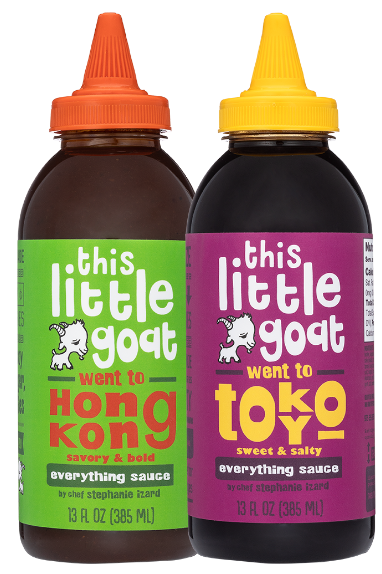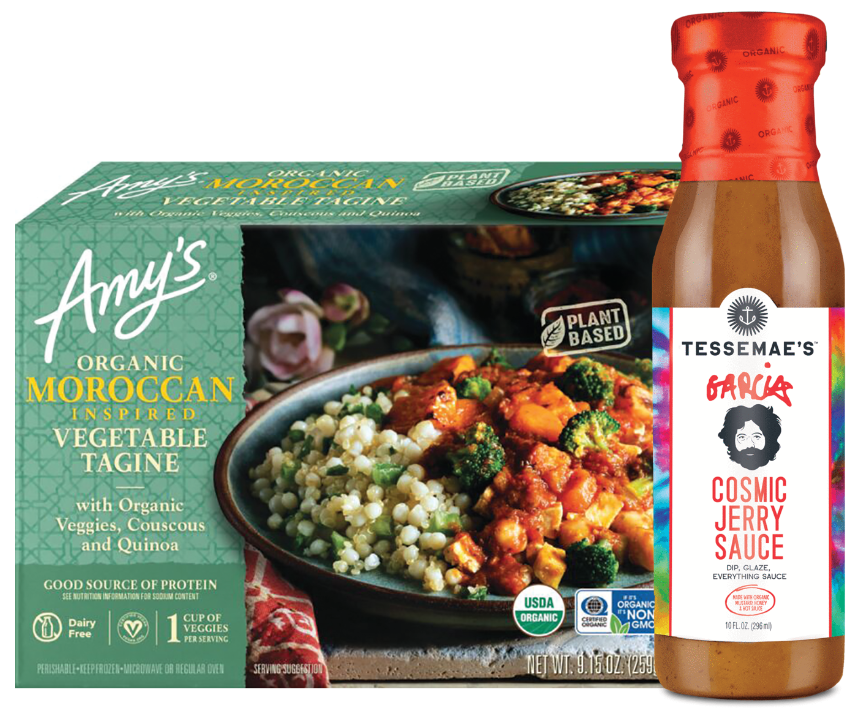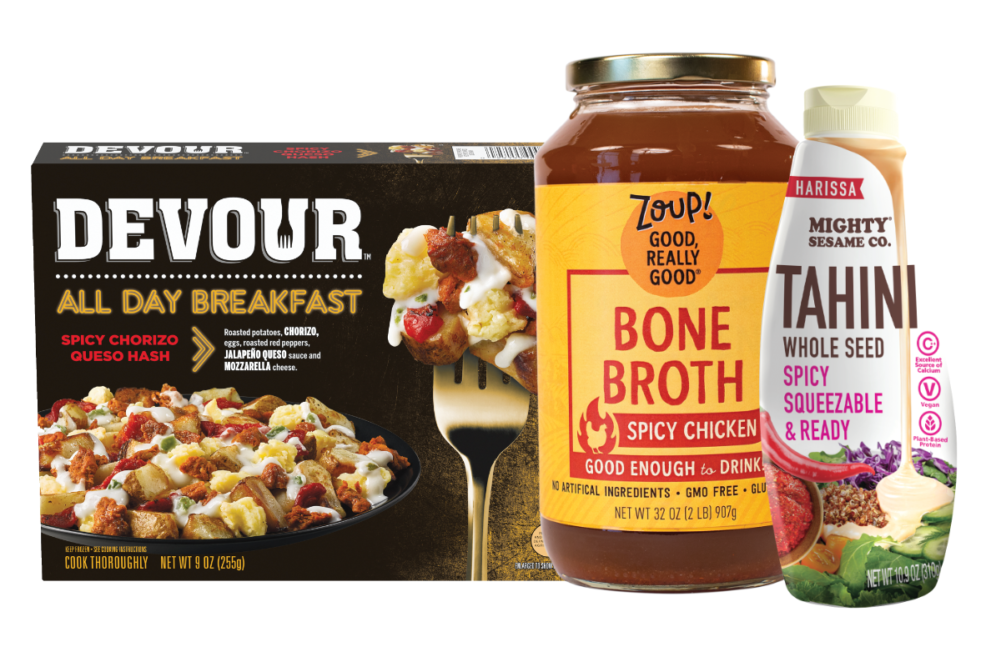CHICAGO — A kick of heat from the addition of organic natural flavors sneaks up on the palate after a few sips of Michelob’s Ultra spicy pineapple organic seltzer. Fire-roasted red peppers, spicy chorizo and jalapeño queso provide a flavor burst when one consumes Devour’s spicy chorizo queso hash, a heat-and-eat frozen breakfast entree. Fermented cabbage, onions and radishes are combined with red pepper extract to make Nasoya’s new spicy kimchi relish, which provides home cooks a convenient way to intensify the flavor of meals.
Exploring new and different spices is helping many overcome the food fatigue they are experiencing because of cooking from home during the pandemic. Manufacturers of heat-and-eat meals, finger foods, soups, sauces and even side dishes are being creative with globally inspired spicy recipes that satisfy the cravings of grounded frequent travelers. Spices assist with delivering varied levels of heat along with authentic taste and visual cues.
When restaurants had to shut their doors to indoor diners, chef Stephanie Izard, owner of Chicago-based Girl and the Goat, Little Goat, and Duck Duck Goat restaurants, was prepared to keep her fans’ taste buds satisfied with the condiments created in her restaurants. They are formulated to make it easy for home cooks to “explore where cooking can take you.”
 The “This Little Goat Went to Hong Kong” variety has savory notes from fermented soy with ginger, garlic and spicy chilies. The Southeast Asia sauce combines salty fish sauce with lemon while the Korea variety is about spicy chilies and soybean paste with a hint of garlic and brown sugar. Yucatan brings sweet heat to the table with bright citrus melding with savory garlic, onion and chilies. “This Little Goat Went to Tokyo” delivers a balance of sweet and salty with a subtle kick from tamari sauce and sake.
The “This Little Goat Went to Hong Kong” variety has savory notes from fermented soy with ginger, garlic and spicy chilies. The Southeast Asia sauce combines salty fish sauce with lemon while the Korea variety is about spicy chilies and soybean paste with a hint of garlic and brown sugar. Yucatan brings sweet heat to the table with bright citrus melding with savory garlic, onion and chilies. “This Little Goat Went to Tokyo” delivers a balance of sweet and salty with a subtle kick from tamari sauce and sake.
The Mighty Sesame Co., Bayonne, NJ, a manufacturer of squeeze-and-serve tahini, has added a harissa-flavored tahini to the line. The new variety contains a blend of spices for an aromatic, roasted chili pepper flavor profile with a kick.
Monin Americas, Clearwater, Fla., a supplier of flavor syrups for coffeehouse, mixologists and foodservice, did a pivot during the pandemic by focusing on culinary innovation to assist chefs with easy ways to add flavor variety to limited menus. Lenten fish sandwiches, for example, get upgraded with wasabi mayonnaise made with the company’s cucumber syrup. Lavender syrup provides subtle floral notes to ghost pepper barbecue sauce.
Such sweet heat has been trending for some time but has taken off since the pandemic, said Ron Spaziani, chef and culinary research and development manager, Nu Products Seasoning Co., Oakland, NJ.
“We are seeing all types of chilies being combined with citrus and tropical flavors, even alcohol flavors,” Mr. Spaziani said. “Think tequila lime chipotle chicken wings.”
Pickling spices used in fermented foods also are trending as a way to add kick, Mr. Spaziani said. Pickling spice blends often include chilies and lots of salt.
“Brine notes heat up foods,” he said. “Throw in some horseradish or other zesty root vegetables, and you can achieve different degrees of spicy.”
Baltimore-based Tessemae’s recently partnered with the Jerry Garcia Family to develop Cosmic Jerry Sauce. The sweet and spicy sauce is a blend of honey, mustard and jalapeño peppers with a hint of umami from fish sauce.
Recognizing that one-third of home grillers are grilling more than they were pre-pandemic, McCormick & Co., Inc., Hunt Valley, Md., is introducing a range of seasoning blends that layer in flavors while providing a subtle kick. Varieties include cracked pepper garlic with sea salt, smoked paprika onion with garlic and pepper, and smoky bacon barbecue. Executive chef Kevan Vetter worked with McCormick’s research and development to ensure the new Grill Mates products contained large particulates that suggest bold flavor. The seasonings are formulated to withstand high cooking temperatures and to be served to the consumer.
Southfield, Mich.-based Zoup! is bringing the heat to the broth aisle with the introduction of a spicy chicken bone broth. The recipe includes red bell, ancho, chili, chipotle and cayenne peppers to give the broth a fiery flavor, plus onion and garlic is added to keep things balanced. It is kettle-cooked in small batches using restaurant-quality cooking methods and standards.
“With over 20 years in the soup business, it’s safe to say we know good broth,” said Eric Ersher, founder and chief operating officer. “With this new product, we’ve taken the guess work out of finding just the right combination of spices and created a complex broth that’s perfect for inspiring the creativity of at-home cooks.”
Like most brands of frozen prepared foods, Amy’s Kitchen, Petaluma, Calif., has been thriving during the pandemic as consumers crave flavor without the hassle. The company knows that the power behind producing prepared foods with authentic flavors is the use of high-quality spices.
“We make most of our seasonings in house in order to keep it in our control,” said Fred Scarpulla, vice president of culinary. “We work with spice companies to source raw materials and take it from there.”
 This is not always easy and has proven to be especially challenging during the pandemic as many spices are imported and being held up at ports domestically and abroad. That has not stopped Mr. Scarpulla and his team from creating new dishes through assistance from the company’s network of professional and home chefs located around the world.
This is not always easy and has proven to be especially challenging during the pandemic as many spices are imported and being held up at ports domestically and abroad. That has not stopped Mr. Scarpulla and his team from creating new dishes through assistance from the company’s network of professional and home chefs located around the world.
New Amy’s Indian-Inspired Vegetable Pakoras starts with chickpea flour dumplings stuffed with organic cauliflower and potatoes. The street food concept is lightly fried and simmered in a savory yogurt curry sauce and served with organic basmati rice. Inspired by the travels of Amy’s founders to renowned London vegetarian restaurant Mildred’s, new Amy’s Organic Moroccan-Inspired Vegetable Tagine combines turmeric, cumin, coriander, cinnamon and fennel with smoked paprika and jalapeño peppers for just the right amount of heat in this vegetable stew.
“We will make chili paste, curry sauce and other ethnic-inspired systems the day before production of the meal,” Mr. Scarpulla said. “This keeps flavors real, fresh and bright. The meals get made and go straight to the freezer. It’s a real game changer in terms of staying authentic.”
Spicing up the butcher counter
With summer approaching and some consumers still wary of visiting a restaurant, retail meat departments are poised to spice up food fatigue with grill-ready, value-added meal solutions. This was a recurring message at the virtual 2021 Annual Meat Conference held March 22-25.
“Value-added meat has been a growth driver for several years, based on the combination of a higher consumption frequency and an increase in household penetration,” said Anne-Marie Roerink, president, 210 Analytics LLC, San Antonio, and author of The Power of Meat study, which was released during the conference. “In 2016, 37% of meat shoppers purchased value-added meat and poultry sometimes or frequently. In 2021, this increased to 68%, an increase of 31 percentage points.”
The survey defined value-added meat as items that are pre-marinated, pre-cut or pre-seasoned, such as kabobs, meatloaf, meatballs or pre-marinated chicken wings. Demographically and behaviorally, high-frequency value-added meat buyers skew toward millennials in urban areas. They have above-average weekly grocery spending, frequently purchase meat/poultry online, but when purchasing in store, they tend to buy meat for one meal at a time, even during the pandemic.
Seasonings are an easy way for butchers to add value to fresh cuts wrapped and sold from behind the meat counter. This allows for flavors of the days and limited specials.
“Lead with a ‘eat with your eyes before you eat with your mouth’ mentality,” said Cody Masters, executive chef, Everson Spice Co., Austin, Texas. “Add depth to the aesthetic.”
He provided an example of a new Santa Maria-style barbecue seasoning, a regional flavor concept most notably applied to tri-tip beef that has started gaining a following beyond the Central Coast of California. The differentiating factor of this spice blend is the visual cues the ingredients provide, which suggest bold, heat and savory.
“Our dry rub contains four colors of peppercorns and the largest particulates possible of dried garlic and onion,” Mr. Masters said. “The blend brightens up everything and is a massive flavorful burst once you chew into it.
“Sweet heat is also really taking off on meat and poultry. Try sriracha honey on chicken breast.”
Another concept combines paprika with spicy, smoky chili notes that gets balanced with brown sugar. And there’s charred lemon pepper, which includes a smoky note, setting it apart from traditional lemon pepper seasoning. These spicy systems add value to everything from bacon to chicken kabobs to meatballs.




